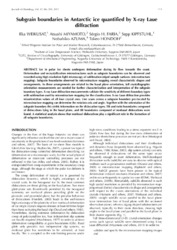Subgrain boundaries in Antarctic ice quantified by X-ray Laue diffraction
Weikusat, Ilka
Miyamoto, Atsushi
Faria, Sergio H.
Kipfstuhl, Sepp
Azuma, Nobuhiko
Hondoh, Takeo
57, 201: 111 - 120
Weikusat, Ilka; Miyamoto, Atsushi; Faria, Sergio H.; Kipfstuhl, Sepp; Azuma, Nobuhiko; Hondoh, Takeo, 2011: Subgrain boundaries in Antarctic ice quantified by X-ray Laue diffraction. In: Journal of Glaciology, Band 57, 201: 111 - 120, DOI: 10.23689/fidgeo-2783.
 |
Dokument öffnen: |
Ice in polar ice sheets undergoes deformation during its flow towards the coast.
Deformation and recrystallization microstructures such as subgrain boundaries can be observed and
recorded using high-resolution light microscopy of sublimation-edged sample surfaces (microstructure
mapping). Subgrain boundaries observed by microstructure mapping reveal characteristic shapes and
arrangements. As these arrangements are related to the basal plane orientation, full crystallographic
orientation measurements are needed for further characterization and interpretation of the subgrain
boundary types. X-ray Laue diffraction measurements validate the sensitivity of different boundary types
with sublimation used by microstructure mapping for the classification. X-ray Laue diffraction provides
misorientation values of all four crystal axes. Line scans across a subgrain boundary pre-located by
microstructure mapping can determine the rotation axis and angle. Together with the orientation of the
subgrain boundary this yields information on the dislocation types. Tilt and twist boundaries composed
of dislocations lying in the basal plane, and tilt boundaries composed of nonbasal dislocations were
found. A statistical analysis shows that nonbasal dislocations play a significant role in the formation of
all subgrain boundaries.
Statistik:
ZugriffsstatistikSammlung:
- Geologie [930]

